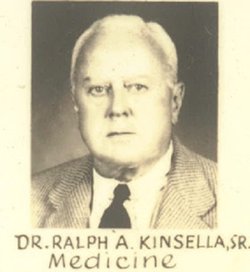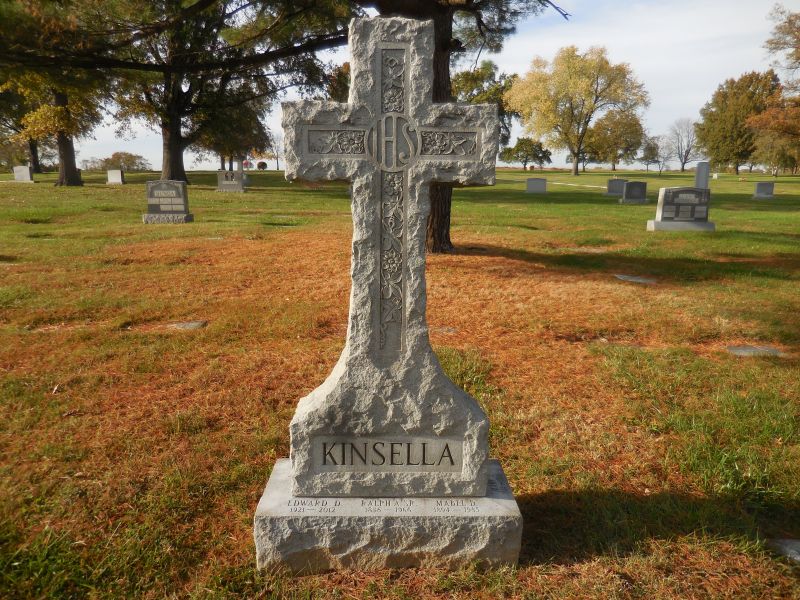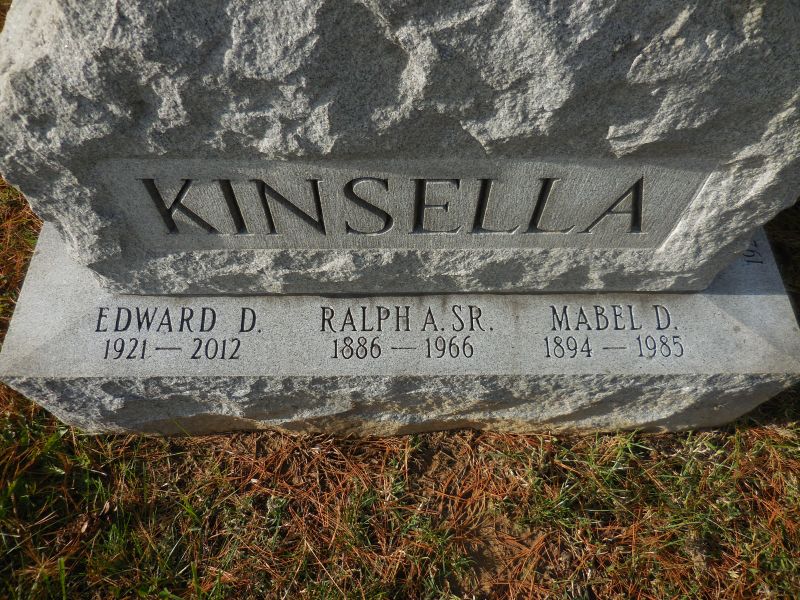Funeral services for Dr. Ralph A. Kinsella Sr., a physician in St. Louis for 55 years, will be at 10 a.m. tomorrow at St. Louis Cathedral. Burial will be in Calvary Cemetery. Dr. Kinsella, 80 years old, died early yesterday at St. Mary's Hospital after suffering a heart attack at his home, 4954 Lindell boulevard. He was on the faculty of the St. Louis University School of Medicine for many years and served as director of the department of internal medicine from 1924 to 1953, when he became director emeritus. Dr. Kinsella was born in St Louis and attended public schools. He received his bachelor's, master's and medical degrees at St. Louis University. After graduation in 1911, he was on the staff at City Hospital until 1914, when he received a research fellowship at ColumbiaUn iversity. In World War I he was a major in the Army Medical Corps. After the war he joined the St. Louis University faculty and remained until 1921, when he went to the Washington University medical faculty. He returned to St. Louis University three years later. Last April he was the first recipient of the annual Ralph Kinsella award, established in his honor by Lambda chapter of Phi Beta Pi medical fraternity at the university. He was chosen for his service to academic medicine as a researcher and physician. He conducted extensive research in endocarditis, rheumatic fever and the cellular mechanisms of infections. He was a member of the City Plan Commission from 1937 to 1944 and of the State Board of Health in 1945 by appointment of the late Gov. Phil M. Donnelly. He was an elected member of the St. Louis charter board of freeholders in 1956-57. He wasformer president of the Missouri Association of Occupational Therapy. Surviving are his wife, the former Mabel Downey; three sons, Dr. Edward D. and Dr. Peler W. Kinsella, internists, with whom he shared offices at 3720 Washington boulevard, and Dr. Ralph A. Kinsella Jr., a faculty member at St. Louis University; a daughter, Miss Mary Janet Kinsella, and 23 grandchildren.(source: St. Louis Post-Dispatch, St. Louis, Missouri, Tuesday, September 6, 1966, Page 3)-[provided by contributor RCS #47313089]
~~~~
~~~~
Ralph A. Kinsella Sr., M.D.(’11), was the first to demonstrate that salicylates, such as aspirin, have anti-inflammatory effects. He also made a major contribution to the understanding of the pathogenesis of infective endocarditis. Following a fruitful career investigating streptococcal infection and endocarditis , Dr. Ralph A. Kinsella Sr., returned to St. Louis in 1919 to establish a research institute at Jewish Hospital. In 1919, Ralph A. Kinsella Sr., M.D.(’11), joins the School of Medicine as a professor in the department of medicine. He receives a federal grant to study infectious diseases. To help investigate the influenza pandemic, he recruits recent School of Medicine graduate Goronwy O. Broun Sr., M.D.(’18), whose sister died from the virus. Together they discover the factors responsible for hemorrhaging in severe cases. He returned to SLU in 1924 as professor of experimental medicine and the physician-in-chief of the newly constructed St. Mary’s Hospital. Together with his friend and collaborator, Dr. Goronwy Broun, he would go on to publish seminal works in inflammatory arthritis, bacterial endocarditis, and St. Louis Encephalitis. In 1924, Kinsella, also known as “Big Red,” is appointed director of the department of medicine and physician-in-chief of the University Hospitals, which consists of St. Mary’s Hospital, St Mary’s Infirmary and Mt. St. Rose Hospital. Associated hospitals include Alexian Brothers, St. Anthony’s and St. John’s. Broun, who left the school to work with some of the most famous virologists of the time, returns to the University and becomes the first full-time faculty member in the department. [Broun notes the] legendary diagnostic skills of his director and teacher, Dr. Ralph Kinsella. He said Dr. Kinsella could walk into the room of a complex and challenging patient and “smell” the diagnosis. The residents under Dr. Kinsella were well trained and masters of physical diagnosis. Ralph produced a slew of Kinsella physicians – Ralph Jr. (endocrinologist and chief of staff at City Hospital), Edward (gastroenterologist at St. Mary’s) and Peter (pulmonologist at St. Mary’s). A generation of nurses at St. Mary’s would help young trainees distinguish the Drs. Kinsella as “Endoscopy Ed” and “Pulmonary Pete.” Ralph Jr. and Peter married physicians as well: Margaret Boyle, M.D., and Maria Stack, M.D., respectively.(primary source: slu.edu)-[edited bio by: RCS]
Funeral services for Dr. Ralph A. Kinsella Sr., a physician in St. Louis for 55 years, will be at 10 a.m. tomorrow at St. Louis Cathedral. Burial will be in Calvary Cemetery. Dr. Kinsella, 80 years old, died early yesterday at St. Mary's Hospital after suffering a heart attack at his home, 4954 Lindell boulevard. He was on the faculty of the St. Louis University School of Medicine for many years and served as director of the department of internal medicine from 1924 to 1953, when he became director emeritus. Dr. Kinsella was born in St Louis and attended public schools. He received his bachelor's, master's and medical degrees at St. Louis University. After graduation in 1911, he was on the staff at City Hospital until 1914, when he received a research fellowship at ColumbiaUn iversity. In World War I he was a major in the Army Medical Corps. After the war he joined the St. Louis University faculty and remained until 1921, when he went to the Washington University medical faculty. He returned to St. Louis University three years later. Last April he was the first recipient of the annual Ralph Kinsella award, established in his honor by Lambda chapter of Phi Beta Pi medical fraternity at the university. He was chosen for his service to academic medicine as a researcher and physician. He conducted extensive research in endocarditis, rheumatic fever and the cellular mechanisms of infections. He was a member of the City Plan Commission from 1937 to 1944 and of the State Board of Health in 1945 by appointment of the late Gov. Phil M. Donnelly. He was an elected member of the St. Louis charter board of freeholders in 1956-57. He wasformer president of the Missouri Association of Occupational Therapy. Surviving are his wife, the former Mabel Downey; three sons, Dr. Edward D. and Dr. Peler W. Kinsella, internists, with whom he shared offices at 3720 Washington boulevard, and Dr. Ralph A. Kinsella Jr., a faculty member at St. Louis University; a daughter, Miss Mary Janet Kinsella, and 23 grandchildren.(source: St. Louis Post-Dispatch, St. Louis, Missouri, Tuesday, September 6, 1966, Page 3)-[provided by contributor RCS #47313089]
~~~~
~~~~
Ralph A. Kinsella Sr., M.D.(’11), was the first to demonstrate that salicylates, such as aspirin, have anti-inflammatory effects. He also made a major contribution to the understanding of the pathogenesis of infective endocarditis. Following a fruitful career investigating streptococcal infection and endocarditis , Dr. Ralph A. Kinsella Sr., returned to St. Louis in 1919 to establish a research institute at Jewish Hospital. In 1919, Ralph A. Kinsella Sr., M.D.(’11), joins the School of Medicine as a professor in the department of medicine. He receives a federal grant to study infectious diseases. To help investigate the influenza pandemic, he recruits recent School of Medicine graduate Goronwy O. Broun Sr., M.D.(’18), whose sister died from the virus. Together they discover the factors responsible for hemorrhaging in severe cases. He returned to SLU in 1924 as professor of experimental medicine and the physician-in-chief of the newly constructed St. Mary’s Hospital. Together with his friend and collaborator, Dr. Goronwy Broun, he would go on to publish seminal works in inflammatory arthritis, bacterial endocarditis, and St. Louis Encephalitis. In 1924, Kinsella, also known as “Big Red,” is appointed director of the department of medicine and physician-in-chief of the University Hospitals, which consists of St. Mary’s Hospital, St Mary’s Infirmary and Mt. St. Rose Hospital. Associated hospitals include Alexian Brothers, St. Anthony’s and St. John’s. Broun, who left the school to work with some of the most famous virologists of the time, returns to the University and becomes the first full-time faculty member in the department. [Broun notes the] legendary diagnostic skills of his director and teacher, Dr. Ralph Kinsella. He said Dr. Kinsella could walk into the room of a complex and challenging patient and “smell” the diagnosis. The residents under Dr. Kinsella were well trained and masters of physical diagnosis. Ralph produced a slew of Kinsella physicians – Ralph Jr. (endocrinologist and chief of staff at City Hospital), Edward (gastroenterologist at St. Mary’s) and Peter (pulmonologist at St. Mary’s). A generation of nurses at St. Mary’s would help young trainees distinguish the Drs. Kinsella as “Endoscopy Ed” and “Pulmonary Pete.” Ralph Jr. and Peter married physicians as well: Margaret Boyle, M.D., and Maria Stack, M.D., respectively.(primary source: slu.edu)-[edited bio by: RCS]
Family Members
Sponsored by Ancestry
Advertisement
Advertisement









